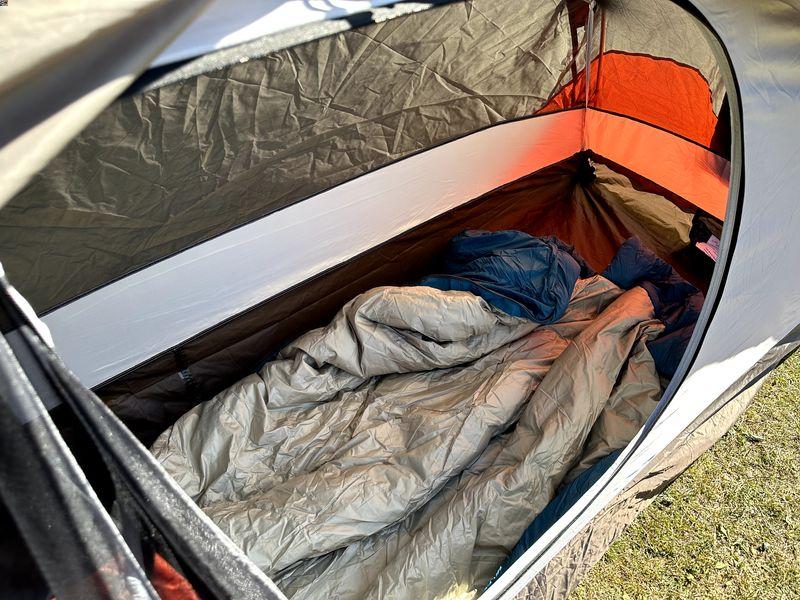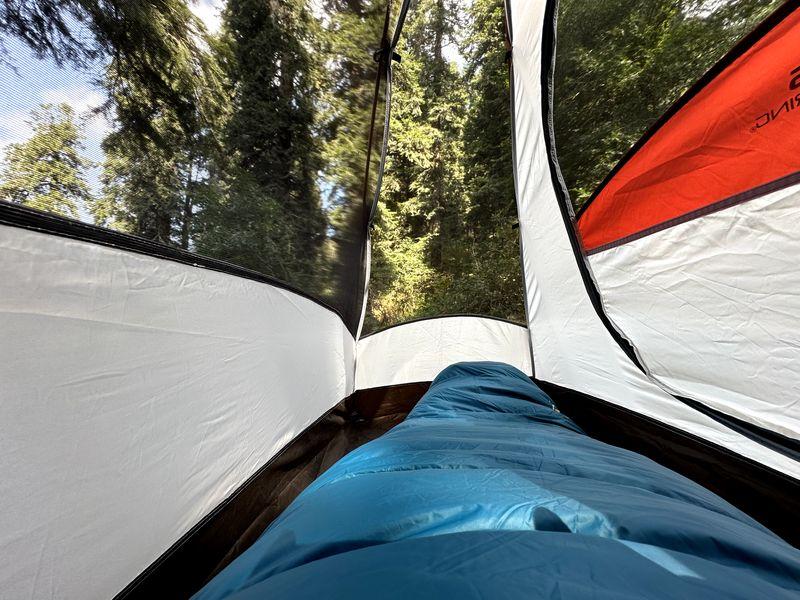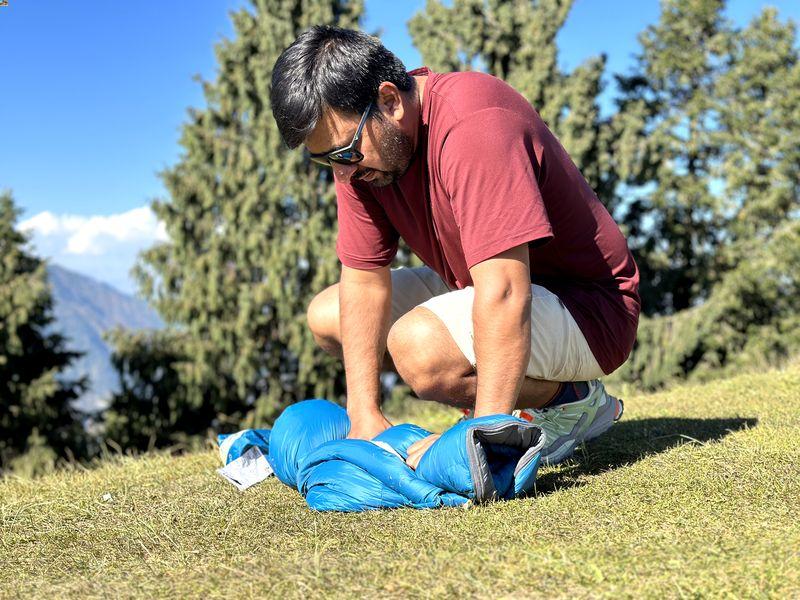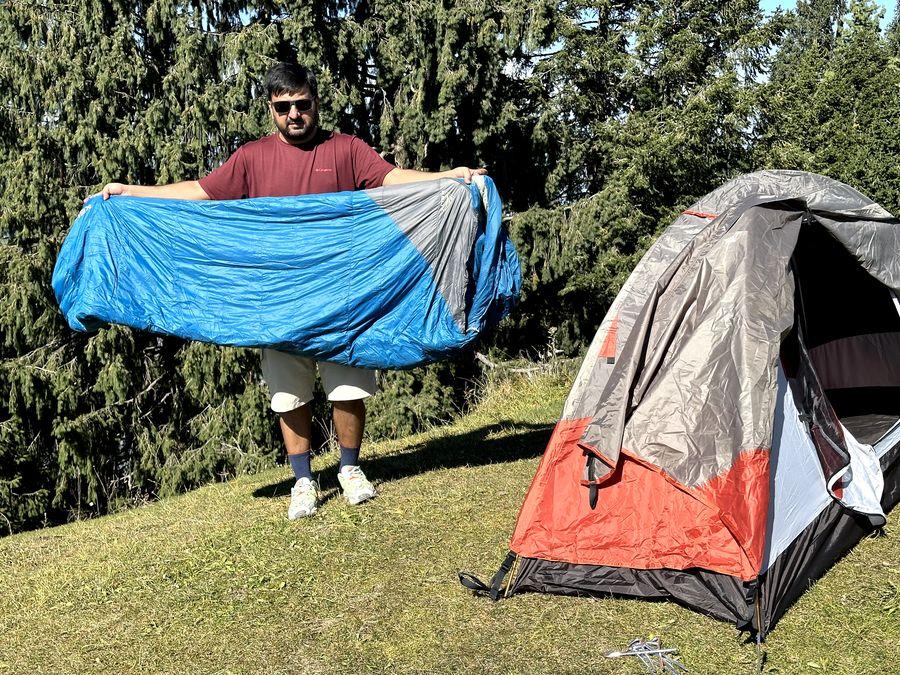Every person who loves nature thinks about spending some time camping and being able to enjoy the time out fully. The most important thing is to find the proper equipment, especially if the length of the trip is more than a day and includes sleeping out in the open.
With good quality of sleep being among the most important aspects of any trip, as it will keep you fresh and help you maintain your strength for any task that awaits, it is important to find the best solution available when it comes to sleeping equipment.
Related: Best Double Sleeping Bags
So, backpacking quilt vs sleeping bag – what should you choose?
In this article, we’ll give you all the information needed so you can find the best possible solution according to your own needs.
Definition and Features
A sleeping bag is, as the name says, a bag used for sleeping when outside. It works how you enter the bag, lay down, zip yourself up, and sleep in it all nicely tucked and warm, covered from all sides.
Although sleeping bags come in many shapes and sizes, their general idea is simple – enter, tuck in, zip it up and you’ll be protected and warm as you take much-needed rest.
On the other hand, quilts lay over your body, tucking you around your sides but without a backside. Also, one of the main differences is the size of the zippers, as they most often have zippers that only cover your legs, with the option of being totally open if needed. It has straps and clips and can be attached to the sleeping mat.
This is a great option for those who need movement during their sleep. Some people, for instance, don’t like their feet movement being limited, or love to feel temperature difference by stretching the feet outside the blanket. While being impossible with a sleeping bag, quilt enables just that.
Sleeping Bag: Pros
A sleeping bag has a few important pros.
Insulation and Warmth
When being outdoors, it is important to stay warm, especially if hiking early in the Spring and late Autumn, when the nights tend to be really cold. Sleeping bags offer insulation and warmth as they prevent your body heat from leaving the bag by being closed and keeping you nice and warm, from your head (thanks to the hoodie) to your toe.

This becomes especially important if the temperature drops during winter or autumn nights when it can make all the difference between fun and potential health problems.
Protection From Elements
Although spending time outside is fun, there are some downsides and stuff that can spoil the fun. Some people have problems sleeping with bugs and insects being all around, and a sleeping bag prevents them from entering and biting.
Also, it will keep you warm and dry, as most of the sleeping bags are water-resistant. This doesn’t mean they are waterproof, so avoid using the sleeping bag in the rain, but otherwise, it will help you stay good.
Convenient and Easy to Use
The usage of sleeping bags is quite simple – you enter, zip yourself up and that’s it. You’re tucked, warm. All you have to do is relax and sleep.
Approximately it takes up to one minute to get your sleeping bag ready, so it it is both fast and easy to use – all you have to do is to place it on your pad (or not, it is completely up to you) for your own comfort and – that’s it.
Sleeping Bag: Cons
Sleeping bags have some cons that can’t be overseen.
Weight and Bulkiness
While you hike or backpack, you want your stuff to be as lightweight as possible. This is where one of the main issues with sleeping bags is.
To keep a hiker warm sleeping bags – especially those used for winter hiking – tend to be quite heavy. Also, with the hoodie and everything, they are bulky and take a lot of space.
Limited Versatility
One of the main issues with sleeping bags is their inability to adapt to specific situations. For instance, they are water-resistant but not waterproof, which means they will keep you dry from a small amount of water but not in the rain.
Also, if you expect big temperature changes, you may need two different bags, as one may not be enough.
Potential Discomfort for Some Sleepers
As stated above, sleeping bags can cause some discomfort during your sleep. First of all, they limit your movability, as you cannot move your arms or legs the way you want.

On the other hand, the hoodie can direct your breath straight into the bag itself, which will increase the level of moisture and make it uncomfortable.
Quilt: Pros
Camping quilt has a few important pros that make it worth checking out as a valid option for your next trip.
Lightweight and Packable
Unlike sleeping bags, quilts are most often lightweight and easy to pack, as they don’t need as much material, which makes them a desirable option. They won’t take much of a space in your backpack.
This comes into play in long-length hikes and trips where you’ll be spending lots of time on your feet, with your equipment packed and on your back.
Customizable Comfort
Unlike sleeping bags, backpacking quilts give you more room to find the optimal sleeping position without limiting your body’s movement. This is especially important during summer when the temperature can be high even during the night time, so the ability to move during your sleep may be the most important plus side of the quilt.
It gives you the freedom to find the most suitable sleeping position without any limitations, so you’ll be able to completely relax and rest.
It’s Cost-effective
With less material used to produce quilt than sleeping bags, quilts are cheaper and more affordable options, so in sleeping bag vs quilt comparison, this is one of the main reasons many hikers and backpackers switch to backpacking quilts.
Quilt: Cons
Basically, like everything else, quilt also has some limitations and cons you should know about before you decide which way to go.
Less Insulation in Extreme Conditions
Unlike a sleeping bag that wraps you up, quilt offers less insulation, which leads to a loss of temperature. When the temperatures become extreme, the fact that you’re not insulated from all sides can be a problem and lead to discomfort and, in some situations, even problems with health (like frostbite, etc.)
Requires Some Skills to Use Effectively
Although not complicated, properly using a sleeping quilt requires some practice, as you’ll have to attach it to your sleeping pad.
It may take some time to learn and master it, but once you do, it won’t be an issue and it will be almost as simple as a sleeping bag to use.
Additional Gear is Needed
By being open on your back, sleeping quilt requires some additional equipment, like sleeping pads and pad straps that will help you attach your quilt to the sleeping pad and prevent it from falling off during the night. It’s not complicated, but it can sometime be annoying.
Related: Best Camping Cot
Comparison of Sleeping Bags and Quilts
Now it is time for a direct sleeping bag vs quilt comparison.
Insulation and Warmth
As an outdoor activity, camping, hiking, or backpacking requires the best possible equipment. This also means you should find the best sleeping system that fits your needs but also checks all the boxes needed for your own safety.
For instance, if you plan to hike during late autumn or early spring, the weather could be wary. Temperatures could suddenly drop during the night, so insulation and warmth are among the most important stuff for your own safety.
When it comes to sleeping bags, you’ll be able to choose from down or synthetic fill. Many users recommend down bags as they are more efficient. Also, you’ll have to pay attention to the temperature rating. Most sleeping bags can be used up to -9ºC, but before you hit the road, make sure you check the weather conditions and whether your bag meets the requirements.
Also, the temperature ratings could vary from manufacturer to manufacturer, so feel free to ask before you buy. There are two things you should learn – comfort rating (the temperature at which a cold sleeper may still feel comfortable) and lower limit rating (the temperature at which a warm sleeper might feel comfortable).
On the other hand, quilts, although not as insulating as sleeping bags, offer warmth and comfort while preventing overheating, which may occur during summer hikes. You could also choose from down and synthetic insulation.
Down is natural, and synthetic is a man-made alternative, but it’s a better option if going somewhere where wet weather is expected. It is also a cheaper option.
Weight and Packability
This is where quilts takes its first clear win. Not only is it way lighter than a sleeping bag, but it is also more simple to pack.
When packing a sleeping bag, you may need to find an instruction manual to learn how to fit the whole bag into the compression sack, which can sometimes be unbelievably annoying and time-consuming.

On the other hand, quilts are not only lightweight but are also quite simple to pack and don’t take up much space.
Sleeping Positions and Comfortable
No matter what sleeping bag shape you decide to try (mummy shape, hood, foot box), the final result will be the same – your space for movement will be limited. Some people are OK with that, but some prefer to have the option to move their body without limitations for full comfort.
Enter quilts. Quilts have adjustable straps, so you’ll be able to make it as firm as you want, with draft collars that will help you completely customize your sleeping experience by making it tighter or looser around your head and foot as needed, helping you add warmth when needed, without additional weight, and without limiting your search for optimal sleeping position and comfort.
Price Range and Affordability
When it comes to price, it all depends on what you’re looking for. If you’re going somewhere where the extreme cold is expected, then you should go with winter sleeping bags. If you go somewhere warm, you’ll have a bit more options.
What makes finding the best sleeping bag or quilt easier (or more complicated) is an amazing number of options, so you’ll be able to find exactly what you like.
And the price itself could vary. While there are many expensive options (with prices going over 600 dollars), you can easily find cheaper brands, even under 100 bucks. That being said, it is more likely you’ll find a great quilt for less money than a great sleeping bag.
If you decide to go economical and find the cheaper option, make sure to read the reviews and ask around before you purchase because, although it is possible to make a great purchase and find a top bag or quilt cheaply, it is better to be safe than sorry, to avoid any potential issues.
Ease of setup
To properly set the sleeping bag up, you’ll need enough space to unroll it, a sleeping pad to place it on, and that’s it. After that, you only have to enter the bag and zip yourself up.
With quilt it is a bit more complicated, as you have to tie it to your sleeping pad, so it takes some more time to master, but once you do, it’s not much of an issue, and it won’t take much of your time.
Conclusion
So, sleeping bag vs quilt – who wins? The answer is – it depends entirely on your own preferences. Both of these can become essential parts of your camping trip, depending on your preferences and needs. Each of these two has its own merits, plus and downsides, so the best option is to try them both to know which one suits you better.
